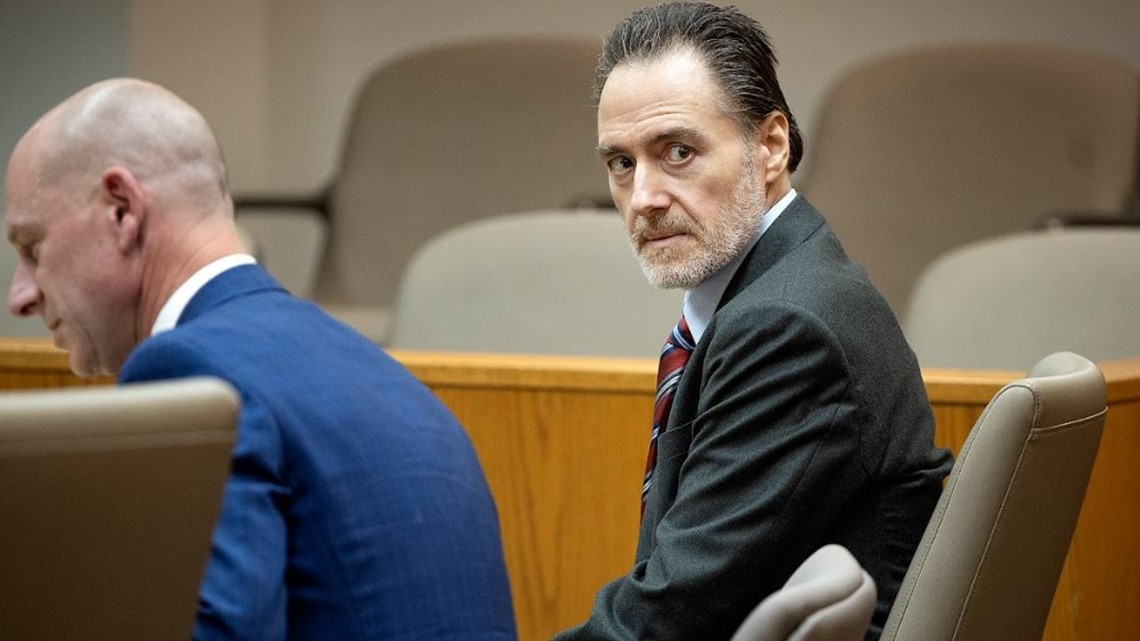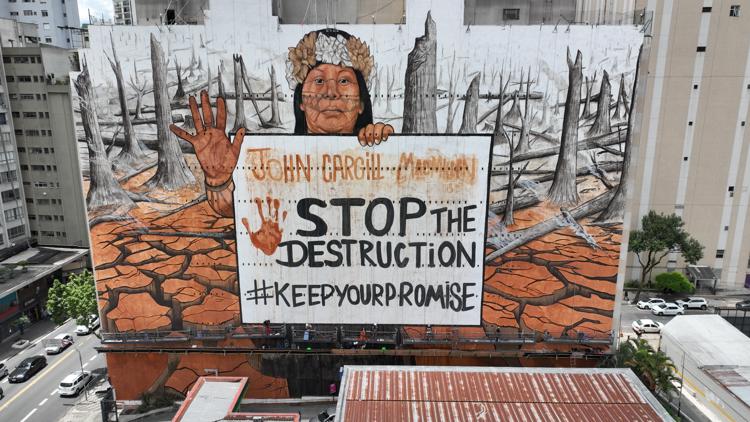Kare11
Apple River stabbing trial: Day 3


The prosecution started the proceedings by calling Anthony Carlson, a man who was stabbed during an altercation with Nicolae Miu.
HUDSON, Wis. — Court reconvened in St. Croix County Wednesday for the trial of Nicolae Miu, who is accused of stabbing five people and killing one teen on the Apple River in July of 2022.
Nicolae Miu is charged with one count of first-degree intentional homicide and four counts of attempted first-degree intentional homicide for allegedly killing 17-year-old Isaac Schuman and injuring four others with a knife.
Prosecutors started the day by calling witness Anthony Carlson, who goes by Tony. He said he was floating on the river with his brother Dante and a larger group when he heard screaming and went over to the altercation to de-escalate the situation. He was yelling at people to back up and get away,
The state went through video footage of the incident frame by frame, showing Carlson getting between Miu and the group of teens that included Isaac Schuman. The witness said he was yelling at the whole group to back up and get away from each other.
Carlson said he put his hand on Miu’s back to tell him to back off from the girls in the group. He said Miu’s hand came up and he batted it away, unknowingly redirecting Miu’s knife down into his stomach.
“At the time, I didn’t know. I thought it was just a punch,” he told the courtroom.
Carlson told the court that Miu struck him again in the lower abdomen with a knife, making a second cut. The witness testified he didn’t remember ever seeing a knife in Miu’s hand.
During cross-examination, Mui’s defense team attempted to paint Carlson as an unreliable narrator, pointing out that his testimony was different than what he told police following the incident.
On Day Two of Miu’s trial, prosecutors called the mother of deceased Isaac Schuman, who gave emotional testimony about her son’s love for his family. Her testimony followed that of Jawahn Cockfield, who took the graphic cell phone video that captured the incident, including the stabbings and the aftermath.
WATCH MORE ON KARE 11+
Download the free KARE 11+ app for Roku, Fire TV, Apple TV and other smart TV platforms to watch more from KARE 11 anytime! The KARE 11+ app includes live streams of all of KARE 11’s newscasts. You’ll also find on-demand replays of newscasts; the latest from KARE 11 Investigates, Breaking the News and the Land of 10,000 Stories; exclusive programs like Verify and HeartThreads; and Minnesota sports talk from our partners at Locked On Minnesota.
Watch the latest local news from the Twin Cities and across Minnesota in our YouTube playlist:
Kare11
Lithium source in Arkansas could meet world demand ‘nine times over’, study says


A study completed by the USGS found that there are lithium reserves located under southwestern Arkansas that’s estimated to between 5 and 19 million tons.
LITTLE ROCK, Ark. — A new study conducted by the United States Geological Survey (USGS) and the Arkansas Department of Energy and Environment (ADEE) discovered a method to “quantify the amount of lithium present in brines located in a geological unit known as the Smackover Formation.”
The study, which was done by the USGS and the ADEE’s Office of the State Geologist, noted that extraction was especially valuable when lithium is extracted from brines that’s been co-produced during oil and gas operation.
“Lithium is a critical mineral for the energy transition, and the potential for increased U.S. production to replace imports has implications for employment, manufacturing and supply-chain resilience,” said David Applegate, USGS Director. “This study illustrates the value of science in addressing economically important issues.”
According to the researchers, the Smackover Formation is described as a “relic of an ancient sea that left an extensive, porous, and permeable limestone geologic unit.” Researchers said that this geological unit dates back to the Jurassic geological time period and currently stretches under parts of Arkansas, along with Louisiana, Texas, Alabama, Mississippi, and Florida.
“Our research was able to estimate total lithium present in the southwestern portion of the Smackover in Arkansas for the first time. We estimate there is enough dissolved lithium present in that region to replace U.S. imports of lithium and more,” said Katherine Knierim, a hydrologist and the study’s principal researcher. “It is important to caution that these estimates are an in-place assessment. We have not estimated what is technically recoverable based on newer methods to extract lithium from brines.”
There’s been more attention to research like this as the global demand for lithium has grown significantly over recent years. Experts expect for the high demand to continue due to how crucial lithium is to battery production, along with a projected trend towards the usage of more electric and hybrid vehicles.
In terms of the U.S., the country relies on imports to sustain over 25% of its lithium. That’s where the extraction of lithium in Arkansas comes into play, as USGS researchers believe that there’s enough lithium in southern Arkansas to cover current estimated lithium consumption for U.S.
USGS said that the low-end estimate is 5 million tons of lithium present in Smackover brines. This would be equivalent to over nine times the International Energy Agency’s projection of global lithium demand for electric vehicles in 2030, according to researchers.
Kare11
Fravel Murder Trial: Prosecutors detail search for Maddi


The first witness called Wednesday was a DNR conservation officer who testified he missed the spot where Kingsbury’s body was found during a prior search.
MANKATO, Minn. — Day five of the murder trial of Adam Fravel opened Wednesday with prosecutors trying to detail the search for and discovery of Maddi Kingsbury’s body.
Fravel is charged with two counts of first-degree murder involving domestic abuse, and two counts of second-degree murder in Kingsbury’s death. Investigators say he killed Maddi after the two dropped their children off at daycare on March 31, 2023, and then buried her remains on a remote property approximately four miles from his parents’ home in Mabel, Minnesota.
Maddi’s decomposing body was discovered on that property on June 7.
KARE 11’s Lou Raguse has covered this case extensively and was in the courtroom in Mankato. He reported the first witness called by prosecutors Wednesday was Minnesota Department of Natural Resources (DNR) conservation officer Mitch Boyum.
Boyum was asked about an April 23 search coordinated with the owners of the property where Kingsbury’s remains were later discovered. The officer told the jury panel that he searched the property that day and found nothing, only to later learn that Maddi had been found in a spot he missed.
“I did not know that culvert was there,” Boyum said.
Raguse reported the prosecution tried to emphasize for jurors that the body was very well hidden and to head off implications from the defense that Kingsbury’s remains might have been moved at some point by someone other than Fravel.
In cross-examination, defense attorney Zach Bauer tried to show jurors just how close conservation officer Boyum was to the spot where Maddi’s body was later found as he approached a gate on the property.
“How close would you have been?” Bauer asked.
“Feet,” Boyum answered.
In redirect, prosecutors attempted to make clear to jurors how easy it would be to spot a body if it had not been so well concealed.
“Trees and logs on the ground would seem ordinary and not caught your attention?” prosecutor Christina Galewski asked.
“Correct,” Boyum answered.
This story will be updated throughout the day as testimony continues.
Kare11
Brazilian artist targets MN-based Cargill with climate mural


Soy farming is one of the biggest drivers of deforestation in the Amazon.
SÃO PAULO, Brazil — Brazilian artist Mundano is presenting a massive street mural in São Paulo on Wednesday that uses ash from wildfires and mud from floods to highlight extreme weather events wreaking devastation across the country — as well as their causes.
Over 30 meters (98.4 feet) high and 48 meters (157.5 feet) wide, the mural depicts deforestation and severe drought in the Amazon Rainforest with its parched brown earth and gray tree stumps. It features Indigenous activist Alessandra Korap wearing a crown of flowers and holding a sign that says: “Stop the destruction #keepyourpromise.”
It is a call to the Minnesota-based soy giant Cargill, according to Mundano. Soy farming is one of the biggest drivers of deforestation in the Amazon.
Cargill says on its website that it will eliminate deforestation from its supply chain in Brazil, Argentina and Uruguay by 2025.
Mundano is seeking to hold them to account.
“We are tired of being a country, a continent where we and the natural resources we have here are exploited… We have to regenerate our planet instead of destroying it,” Mundano said in an interview on Tuesday.
Cargill did not immediately respond to a request for comment on Wednesday morning.
Over the past few months, uncontrolled human-caused wildfires have ravaged protected areas in the Amazon, the vast Cerrado savanna and the world’s largest tropical wetland area, the Pantanal. Those blazes have spread smoke over a vast expanse, choking residents of some cities.
Drought has caused a critical situation nationwide, and forecasts indicate it will persist in much of the country through at least the rest of the month, according to a Sunday report from Cemaden, Brazil’s disaster warning center.
Climate change — primarily caused by the burning of fossil fuels such as oil, gas and coal — leads to frequent and more extreme alterations in weather patterns.
The depth of the Amazon’s Negro River was 12.46 meters (41 feet) on Tuesday, a slight increase from 10 days earlier when it registered its lowest level since measurements started 122 years ago. Tuesday’s depth was still around 6 meters (20 feet) less than usual for the same date in prior years, according to data from the Manaus port.
Rivers in Brazil’s Amazon always rise and fall with its rainy and dry seasons. But the dry season this year has been much worse than usual.
Earlier this year, an unprecedented flood in the southern state of Rio Grande do Sul killed more than 180 people, affected over 2 million people and destroyed urban communities.
Mundano, who calls himself an “artivist,” used mud from that flood collected by the activist group Movement of People Affected by Dams in the mural, as well as ashes from the Amazon, the Atlantic Forest, the Pantanal and the Cerrado. He also used earth thrown away in dumpsters in Sao Paulo and clay collected from the Sawre Muybu Indigenous land in the Amazon, from where Korap hails.
“From floods to droughts, everything is connected!” Mundano said in an Instagram post on Tuesday, accompanied by a video showing the mural in Sao Paulo, which the artist said was his biggest ever.
Three years ago, Mundano employed ash from the Amazon to create a similar mural in Sao Paulo. That work depicted a firefighter standing amid deforested areas and featured a cattle ranch as well as trucks loaded with logs.




